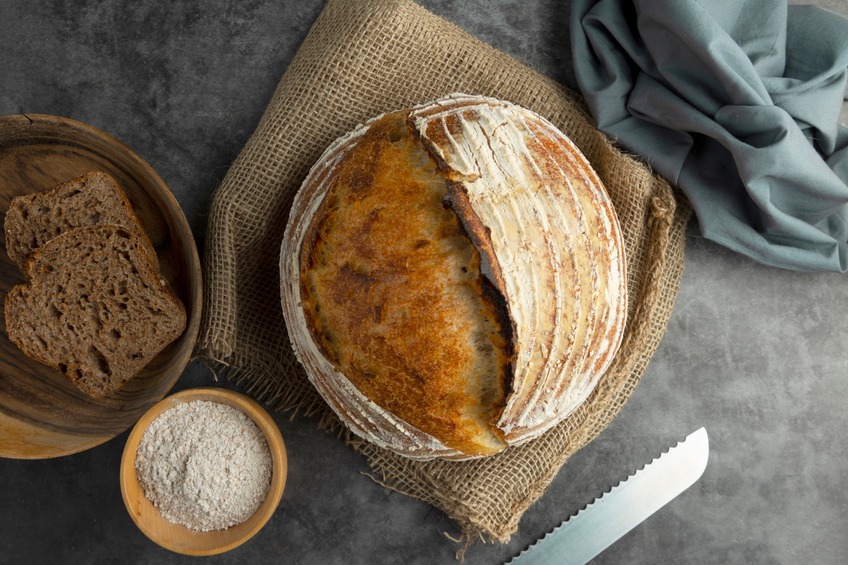 Homemade sourdough bread has gained immense popularity among baking enthusiasts in recent years.
Homemade sourdough bread has gained immense popularity among baking enthusiasts in recent years.
The unique flavor, texture, and health benefits make it a favorite choice for many.
However, one common question that arises is, “How long does homemade sourdough bread last?”
In this article, we will explore the factors that influence the shelf life of homemade sourdough bread and provide some tips on how to maximize its freshness.
Understanding the Shelf Life of Homemade Sourdough Bread
The shelf life of homemade sourdough bread can vary depending on several factors.
These factors include the ingredients used, the baking process, and the storage conditions.
Unlike commercially produced bread, which often contains preservatives, homemade sourdough bread is typically free from artificial additives, making it more perishable.
Factors Influencing the Shelf Life

- Ingredients
The quality of the ingredients used in sourdough bread can affect its shelf life.
Using fresh and high-quality flour, water, and starter culture is essential.
Additionally, the type of flour used, such as whole wheat or rye, can impact the bread’s longevity.
- Fermentation
The fermentation process plays a crucial role in sourdough bread.
Adequate fermentation allows the dough to develop flavor and structure.
Under-fermented bread may spoil more quickly, while over-fermented bread can become too sour and lose its freshness.
- Storage Conditions
Proper storage is key to extending the shelf life of sourdough bread.
Storing the bread in a cool, dry place, away from direct sunlight, helps prevent mold growth and staling.
Alternatively, storing the bread in a paper bag or a bread box can help maintain its texture and moisture.
- Average Shelf Life of Homemade Sourdough Bread
On average, homemade sourdough bread can last for 3 to 5 days.
However, this is just a general estimate, and the actual shelf life may vary.
Factors such as the bread’s hydration level, ambient temperature, and humidity can influence its longevity.
Higher hydration bread with a chewy crumb tends to have a shorter shelf life compared to lower hydration bread with a denser texture.
Signs of Spoilage
It’s important to be able to identify when sourdough bread has gone bad.
Here are some common signs of spoilage:
- Mold
Visible mold growth is a clear indication that the bread has spoiled.
Discard the bread immediately if you notice any mold.
- Stale Texture
As sourdough bread ages, it tends to become dry and lose its softness.
If the bread feels excessively hard or crumbly, it may have gone stale.
- Off Odor
If your sourdough bread emits a strange or unpleasant odor, it’s a sign that it has started to spoil.
Maximizing the Freshness of Homemade Sourdough Bread
 To make your homemade sourdough bread last longer, consider the following tips:
To make your homemade sourdough bread last longer, consider the following tips:
- Slice and Freeze
If you have a large loaf and don’t plan to consume it all within a few days, consider slicing it and freezing individual portions.
Frozen sourdough bread can be toasted or reheated whenever needed.
- Proper Storage
Store the bread in a breathable container, such as a paper bag or bread box.
Avoid using plastic bags, as they can trap moisture and promote mold growth.
- Reviving Stale Bread
If your sourdough bread has gone slightly stale, you can revive it by sprinkling some water on the crust and reheating it in the oven.
This helps restore moisture and freshness.
Bread Storage Made Easy
Finding the right storage solution for your bread is essential to maintain its freshness and prolong its shelf life.
Here are four excellent items that can effectively store your bread, ensuring its quality and taste are preserved.
- Vintage Bread Box
The AVV Farmhouse Bread Box is a stylish and spacious storage container designed to keep your bread fresh on the kitchen countertop.
Its metal construction, combined with a vintage white finish, adds a touch of rustic charm to your kitchen decor.
- Fall Front Bread Box
This Brabantia Fall Front Bread Box features a fall-front lid design that provides easy access while keeping your bread fresh.
It has a compact size and a stylish appearance that complements any kitchen decor.
- Stainless Steel Bread Box
This bread bin not only provides a spacious storage area for your bread but also doubles as a convenient cutting board.
The stainless steel construction offers durability, and the lid keeps your bread fresh and easily accessible.
- Wooden Bread Box
The Lohasok Bread Box is a farmhouse-inspired bread container designed to keep your bread fresh and organized on the kitchen countertop.
Its large size accommodates various bread sizes, while the clear window allows you to easily monitor the contents without opening the box.
A selection of bread boxes that offer functionality, durability, and style, helping you store your bread in the best possible way.
By investing in one of these items, you can ensure that your bread remains fresh and delectable for extended periods, enhancing your overall bread enjoyment.
Bottom Line – How Long Does Homemade Sourdough Bread Last?
 Homemade sourdough bread is a delicious and nutritious treat that can be enjoyed for severaldays when stored and handled properly.
Homemade sourdough bread is a delicious and nutritious treat that can be enjoyed for severaldays when stored and handled properly.
While its exact shelf life can vary based on factors like ingredients, fermentation, and storage conditions, following these guidelines can help maximize its freshness.
By understanding the signs of spoilage and employing techniques like freezing and proper storage, you can savor your homemade sourdough bread for longer, ensuring that every slice is a delight to enjoy.






